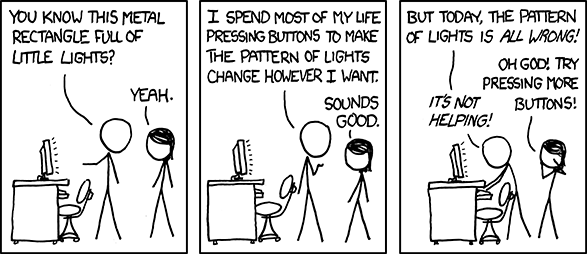Here is a scenario that you have probably already experienced: you intervene on a new project and your first reflex is to read the README file to understand what is going on, then starting your development. You begin to realize that this README is no longer very up-to-date and that some versions have changed. You advance by trial and error then give up by asking for help from another developer to finish your installation.

With a bit of luck, we can find the correct commands after few tries to install the project.
It is safe to say that a bad introduction on a project has never increased a developer’s motivation. And yet, we let these things linger in the hope that a developer will write a README up-to-date until the next major change on the project.
Make is a program that you have probably manipulated since it has existed since 1976 and its use is almost mandatory with C. Its main use case is the automation of the compilation phase of a project. It has become a standard in the world of the computer development with its simplicity and the enthusiasm it has received.
In fact, to launch the compilation of most C projects (the Linux kernel for example), we just need to run the make command in a shell.
Most of these projects are equipped with a Makefile at the root.

Make can organize the compilation phase with a recursive manner giving a fancy description of it in the
Makefile.
If I mention this tool to you today, it is because it is usable on all moderns operating systems.
It can automate the installation of a project regardless of the technologies used on it.
In fact, make will use the default interpretor of the system to execute the commands described in the Makefile.
Let’s take a real-world example, a Java Spring MVC project with a Tomcat instance as a Docker container.
We start by creating a Makefile file at the root of the project to write several rules.
They are made up as follows:
<name of the rule>: <lists of prerequisites to execute before this rule>
<command_1>
<command_2>
...
# We can also put conditions:
ifneq (...)
...
endif
NB: Complete documentation on syntax
We create a first rule which will allow you to check if you have all necessary tools to build/start the project.
JAVA_VERSION = 13
check:
ifneq ($(shell java -version 2>&1 | grep $JAVA_VERSION > /dev/null; printf $$?), 0)
@echo -e "\e[0;31mIncorrect Java version, please use JDK$JAVA_VERSION }.\e[0m"
@exit 1
endif
ifneq ($(shell command -v mvn 2>&1 | grep mvn > /dev/null; printf $$?), 0)
@echo -e "\e[0;31mPlease install Maven.\e[0m"
@exit 1
endif
ifneq ($(shell command -v docker 2>&1 | grep docker > /dev/null; printf $$?), 0)
@echo -e "\e[0;31mPlease install Docker.\e[0m"
@exit 1
endif
The @ character allows to make invisible the launched commands in the standard output.

Without Java 13, the
make checkcommand tells me that I don’t own the correct Java version for this project.
Once the tools verification done, we define the automatisation of the install phase:
# An installation example with a Java project with a static dependency.
install: check
docker-compose up -d
mvn install:install-file -DgroupId=com.proxiad -DartifactId=utils -Dversion=1.0.0 -Dpackaging=jar -DgeneratePom=true -Dfile=jars/proxiad-utils.jar
mvn clean package -DskipTests
build: check
docker stop tomcat
mvn clean package
docker start tomcat
docker logs -f --tail 100 tomcat
The build rule will:
- Run the
checkrule as prerequisite. - Stop the Tomcat container.
- Compile a new
.warfile. - Restart the Tomcat container by following the last 100 lines of the container’s logs.
With this prerequisite definition, we know that the build rule cannot be executed until our envrionment is set to the correct versions.
We add the following two rules:
cleanwhich deletes the build files and the container.formatlaunching the project formatting with spotless :
clean:
docker stop tomcat > /dev/null
docker rm tomcat > /dev/null
git reset --hard && git clean -dffx
format:
@mvn spotless:apply
We therefore get the following Makefile file:
JAVA_VERSION=13
all: build
install: check
docker-compose up -d
mvn install:install-file -DgroupId=com.proxiad -DartifactId=utils -Dversion=1.0.0 -Dpackaging=jar -DgeneratePom=true -Dfile=jars/proxiad-utils.jar
mvn clean package -DskipTests
build: check format
docker stop tomcat
mvn clean package
docker start tomcat
docker logs -f --tail 100 tomcat
clean:
docker stop tomcat > /dev/null
docker rm tomcat > /dev/null
git reset --hard && git clean -dffx
format:
@mvn spotless:apply
check:
ifneq ($(shell java -version 2>&1 | grep $JAVA_VERSION > /dev/null; printf $$?), 0)
@echo -e "\e[0;31mIncorrect Java version, please use JDK$JAVA_VERSION }.\e[0m"
@exit 1
endif
ifneq ($(shell command -v mvn 2>&1 | grep mvn > /dev/null; printf $$?), 0)
@echo -e "\e[0;31mPlease install Maven.\e[0m"
@exit 1
endif
ifneq ($(shell command -v docker 2>&1 | grep docker > /dev/null; printf $$?), 0)
@echo -e "\e[0;31mPlease install Docker.\e[0m"
@exit 1
endif
The
allrule is associated with execution of themakecommand without arguments.
With some imagination, we could integrate a install-front rule and a run-front rule handling the installation and the build of a front-end in a subfolder ui.
install-front:
cd ui && npm install
run-front:
cd ui && npm run start
Make is a standard. This is what makes it powerful. If someone looks at a new project and sees that a Makefile has been made, they will determine that it will be up-to-date and functioal since previous developers have used it. However, take precautions during your first uses, this is very capricious about syntax.